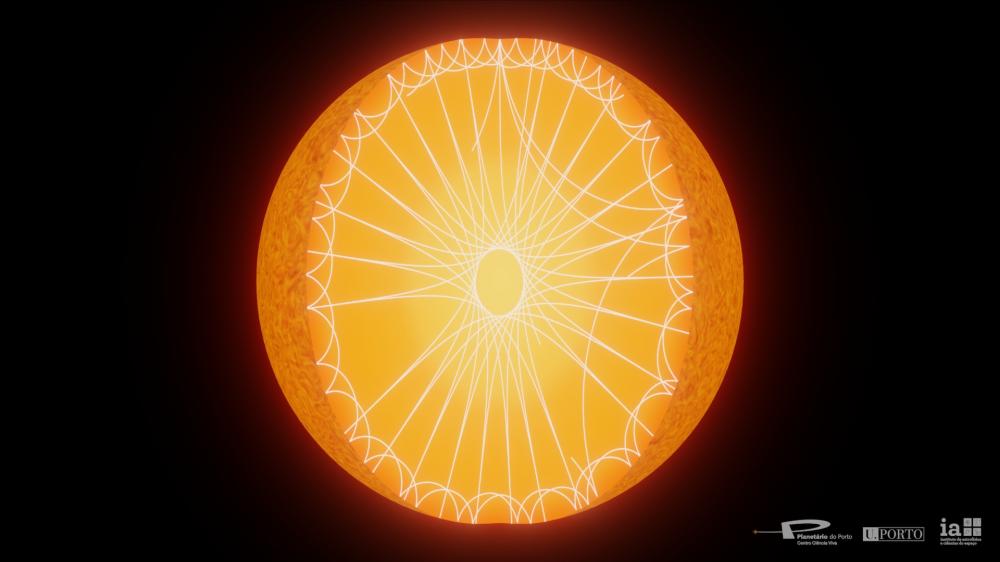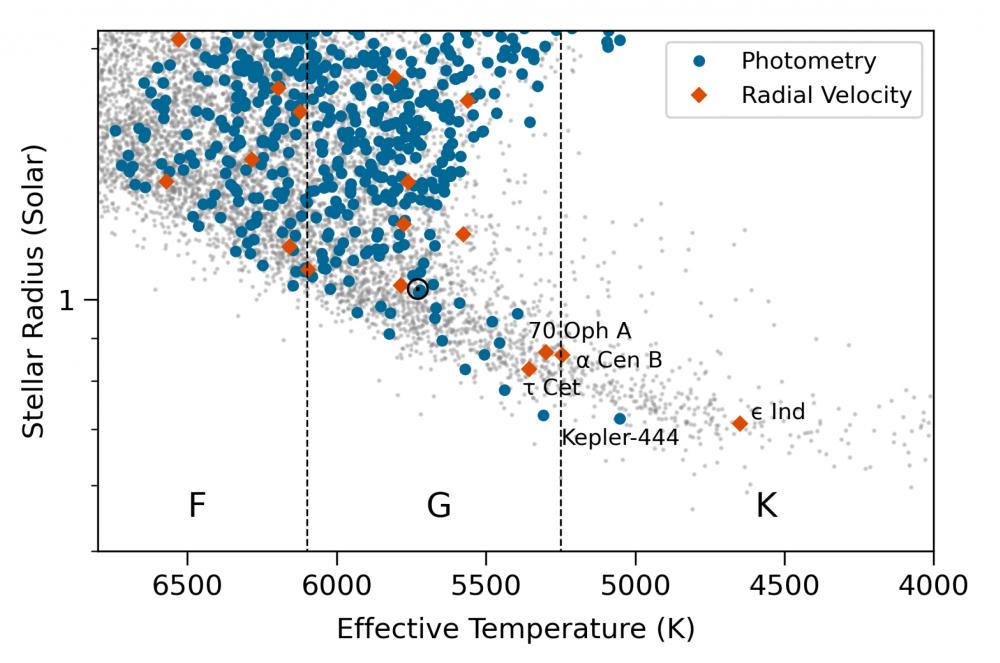
Impression d’artiste des ondes sismiques se propageant au sein de l’étoile à des couches plus ou moins profondes en fonction de leurs fréquences. L’étude de ces différents modes de vibration au niveau de la surface de l'étoile nous informe quant à la structure et la composition des différentes couches stellaires, tout comme un échogramme nous permet de voir l'intérieur de notre corps.
Crédit : Tania Cunha (Planetário do Porto - Centro Ciência Viva)/Instituto de Astrofísica e Ciências do Espaço)
An international team, including the Astrophysics Department of CEA-Saclay, led by the Instituto de Astrofísica e Ciências do Espaço (IA), utilized one of the world's most advanced spectrographs to detect the smallest "stellar tremors" ever recorded in an orange dwarf star, making it the smallest and coldest star observed to date with confirmed solar oscillations. This study demonstrates that asteroseismology is a powerful technique for studying such stars, opening new perspectives in our understanding of stellar physics and, by extension, exoplanets.
This study is published in the journal Astronomy & Astrophysics Letters: “Expanding the frontiers of cool-dwarf asteroseismology with ESPRESSO: Detection of solar-like oscillations in the K5 dwarf ε Indi”.
Incredibly precise measurements...
Located at a distance of 11.9 light-years, Epsilon Indi (ε Indi) is an orange dwarf star (also known as a K dwarf) with a diameter of 71% that of the Sun. To observe this small star, the team of scientists used the powerful ESPRESSO spectrograph, mounted on the Very Large Telescope (VLT) of the European Southern Observatory (ESO).
The team then employed a technique called asteroseismology to measure stellar tremors. These seismic oscillations, measurable only at the surface of the star through photometry or radial velocity, contain rich information as they propagate throughout all stars. They provide precise measurements of fundamental stellar parameters (mass, radius, age) as well as an indirect glimpse into the interior of the star, such as its structure and composition, akin to how terrestrial earthquakes inform us about the Earth's interior.
In the case of ε Indi, the maximum amplitude of the detected oscillations is only 2.6 centimeters per second, which is 14% of the amplitude of solar oscillations, making it the smallest and coldest dwarf star observed to date with confirmed solar oscillations. These measurements are so precise that the detected speed is slower than the average speed of a sloth!
"The extreme precision level of these observations is an outstanding technological achievement. Importantly, this detection conclusively shows that precise asteroseismology is possible down to cool dwarfs with surface temperatures as low as 4200 degrees Celsius, about 1000 degrees cooler than the Sun's surface, effectively opening up a new domain in observational astrophysics," comments Tiago Campante, principal investigator of the study and assistant professor at the Department of Physics and Astronomy of the Science Faculty of the University of Porto (DFA-FCUP).

Diagramme du rayon stellaire en fonction de la température effective, mettant en évidence les détections sismiques des campagnes de photométrie Kepler et TESS (cercles bleus) et de vitesse radiale (diamants rouges). Les lignes pointillées délimitent les classes spectrales des étoiles.
? Indi est l'étoile la plus petite et la plus froide analysée en astérosismologie.
Crédit : Campante et al. 2024
... opening up a whole new world of possibilities!
This level of precision might help scientists settle a long-standing disagreement between theory and observations in what concerns the relation between the mass and the diameter of these cool-dwarf stars. “Stellar evolution models are known to underestimate the diameter of K dwarfs by 5-15% compared to the diameter obtained from empirical methods. The study of oscillations in K dwarfs, via asteroseismology, will help identify the deficiencies of current stellar models and, thus, improve them, so as to eliminate this discrepancy”, explains IA researcher Margarida Cunha.
Despite some initial skepticism that the detection of such oscillations could be beyond the reach of our current instrumental capabilities, Mário João Monteiro (IA & DFA-FCUP) explains that: ”Further to detecting the presence of solar-like oscillations in ε Indi, we now hope to use the oscillations to study the complex physics of the surface layers in K dwarfs. These stars are cooler and more active than our Sun, making them important laboratories to probe key phenomena taking place at their surface layers that we have not yet studied in detail in other stars.”
Furthermore, since orange dwarf stars and their planetary systems have very long lifespans, they have recently become a primary focus in the search for habitable worlds and extraterrestrial life. This result demonstrates that the power of asteroseismology can now potentially be put to use in the detailed characterization of such stars and their habitable planets, with truly far-reaching implications. Moreover, the precise determination of the ages of nearby cool dwarfs made possible by asteroseismology may be critical in interpreting biosignatures in directly imaged exoplanets.
These “starquakes” can now be used to help plan the future European Space Agency’s (ESA) PLATO space telescope, a mission in which the Department of Astrophysics is strongly involved. The oscillation amplitudes measured in this study can be converted to amplitudes in photometry, as they will be measured by PLATO, this being a key piece of information to help accurately predict the seismic yield of PLATO, scheduled to be launched in 2026.
Contacts : Rafael Garcia
• Structure and evolution of the Universe › Planets, star's formation and dynamics, interstellar medium
• Department of Astrophysics (DAp) // UMR AIM
• Laboratory Dynamics of Stars, Exoplanets and their Environment
• PLATO




